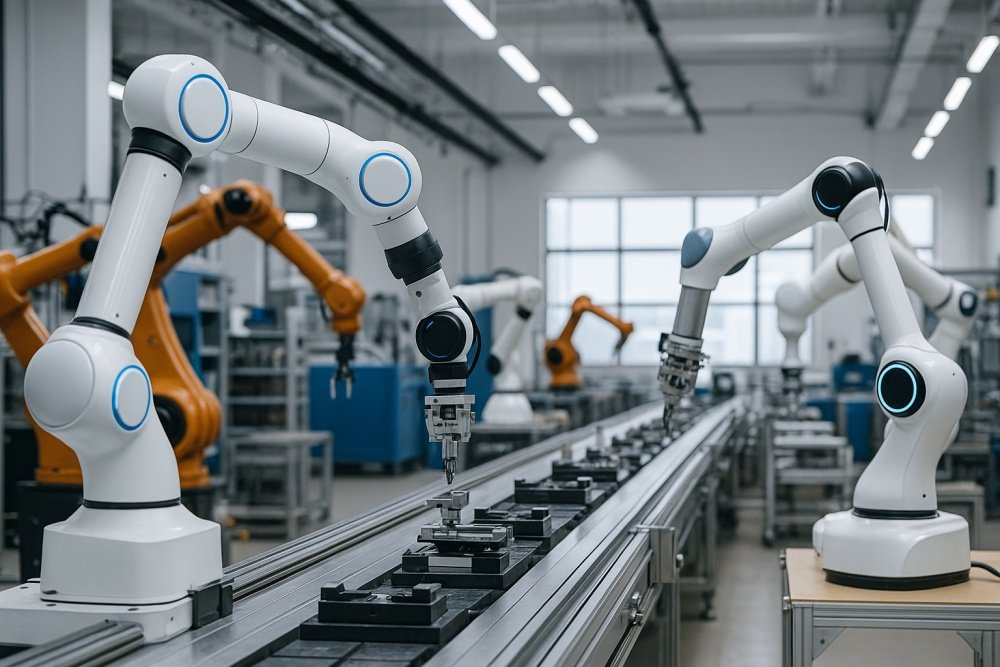As factories race toward greater efficiency and flexibility, advanced robotics in manufacturing has moved from an experimental technology to a global production standard.
From automotive assembly lines to medical-device factories, robots now handle tasks once performed only by humans—delivering speed, accuracy, and consistency that define modern manufacturing.
This article explores the types of manufacturing robots, the rise of collaborative robots in manufacturing, and how robotic arms for manufacturing continue to evolve to meet new challenges.
Types of Manufacturing Robots
Industrial robots are not a one-size-fits-all solution. Each category has unique strengths and is suited to specific production needs:
- Articulated Robots
The most common type, articulated robots feature rotating joints that mimic a human arm. They excel in welding, painting, and machine tending. - SCARA Robots
Known for their selective compliance, SCARA robots provide fast and precise horizontal movement, ideal for electronics assembly and pick-and-place tasks. - Delta Robots
Lightweight and incredibly quick, delta robots are popular in food packaging and high-speed sorting. - Cartesian (Gantry) Robots
These robots move along three linear axes (X, Y, Z) and offer exceptional accuracy, making them perfect for CNC machining and additive manufacturing support. - Collaborative Robots (Cobots)
A rapidly growing category, collaborative robots in manufacturing are designed to safely share workspaces with humans. Built-in sensors and force feedback let them stop or adjust when encountering obstacles, opening new possibilities for flexible production.
Understanding these types helps manufacturers select the right automation strategy and optimize return on investment.

Collaborative Robots: A Manufacturing Game-Changer
Among all categories, collaborative robots in manufacturing—or cobots—have sparked the most excitement in recent years.
Unlike traditional industrial robots that require safety cages, cobots are equipped with advanced sensing and control systems, allowing them to work side by side with human operators.
Key benefits of cobots include:
- Ease of Deployment – Simple programming and lightweight design enable quick installation and redeployment.
- Flexibility – Cobots can switch between tasks like packaging, quality inspection, and machine loading within minutes.
- Improved Safety – Force-limiting sensors reduce risk of injury, making them ideal for small and mid-sized factories.
It’s no surprise that leading collaborative robot manufacturers are seeing rapid growth as industries seek versatile automation that complements human skills.
Robotic Arms for Manufacturing
The classic robotic arm for manufacturing remains the workhorse of industrial automation.
Today’s arms integrate precision servo motors, high-strength lightweight alloys, and advanced control software to achieve sub-millimeter accuracy and 24/7 reliability.
Recent innovations include:
- Integrated Vision Systems – Cameras and AI-driven recognition allow robotic arms to adapt to part variations.
- Additive Manufacturing Support – Some robotic arms now handle 3D printing heads, combining subtractive and additive manufacturing robots in hybrid production cells.
- Modular End Effectors – Quick-change grippers and welding tools reduce downtime between tasks.
These advances make robotic arms indispensable for industries ranging from automotive to aerospace.
Advanced Robotics Driving Smart Factories
The shift toward advanced robotics in manufacturing supports the concept of the “smart factory,” where data and automation work together.
Sensors and IoT connectivity enable predictive maintenance, energy optimization, and real-time quality control.
As robots become more intelligent and interconnected, manufacturers can respond faster to market demands and reduce waste.
Automated guided vehicles (AGVs) are also part of this transformation.
An AGV robot manufacturer can integrate self-driving carts into production lines, ensuring efficient material transport between workstations and warehouses.
Challenges and Considerations
While the benefits of advanced robotics are clear, successful adoption requires careful planning:
- Workforce Training – Employees must learn to program, monitor, and maintain robotic systems.
- Initial Investment – Although long-term savings are significant, upfront costs for equipment and integration can be high.
- Supply Chain for Components – Reliable sources of precision mechanical parts are critical to prevent downtime.
These factors highlight the importance of strong partnerships with technology providers and component manufacturers.
Conclusion: Preparing for a Robotic Future
The future of manufacturing belongs to those who embrace automation.
From understanding the types of manufacturing robots to leveraging collaborative robots in manufacturing and next-generation robotic arms for manufacturing, companies that adopt advanced robotics gain flexibility, quality, and competitive advantage.
For manufacturers seeking high-precision components to keep these systems running flawlessly,
Dongguan Huade Precision Manufacturing Co., Ltd. offers ISO-certified CNC machining services and rapid prototyping of custom robotic parts.
Our expertise ensures that the robots of tomorrow—whether cobots, AGVs, or hybrid additive manufacturing systems—perform with the reliability modern production demands.
